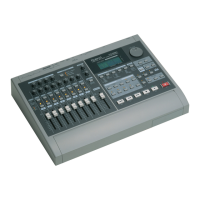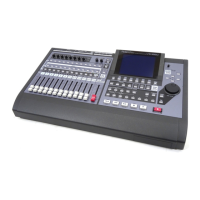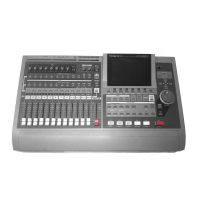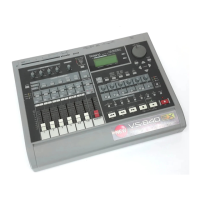5—Understanding Effects
82 www.RolandUS.com Roland VS-2400CD Owner’s Manual
We’ll describe this procedure in more detail on Page 209.
Getting the Most From Your Effect Processors
It’s important to be strategic about how you employ your effects so that you’ll have the
effects you need at each step along the way as you record and mix your project. Even
engineers in the best-equipped studios in the world may find that they wish they had
one more effect processor available from time to time. The simple truth is that while an
effect processor’s creating a particular effect, it’s not available for any other use.
Here’s an example. If you’ve got only the factory-installed effect processing in your
VS-2400CD and are already using Effect 1 and 2, you don’t have any other internal
effect processors available for a third effect. (This is why we recommend installing an
additional VS8F-2 Effect Expansion Board in your VS-2400CD.)
Consider Recording Your Effects As You Go
The solution is planning. Try to work out in advance the effects you’ll need for all of the
elements in your project. This will allow you to budget your effect-processing power.
One of the main tricks you can use to be sure you’ve got all the effects you need is to
apply a signal’s effect as you record the signal—the resulting track contains both the
signal
and
its effect. This is called “printing” the effect. The benefit of recording your
effects as you go is that it frees up the effect processor for later use.
This method isn’t without risk, however: Once you’ve recorded an effect onto a track
along with a signal, the effect can’t be altered or removed. It can also be difficult to
anticipate how a signal and its effect will sound when all other project elements have
been recorded and are in place.
If you’ve got spare tracks, you can hedge your bets by recording the signal on one track,
its effect on another, and then combining them later into a single track—or pair of
tracks if you’re using a stereo effect—once you’re sure you like what you’ve got.
Even so, printing effects with your tracks can be a real lifesaver in a project that needs
lots of effects.
Printing effects can also make a mix easier, since the printed effects will have already
been dealt with, freeing you up to concentrate on other details during the often-
complex mixing process.
Even though an external effect is always a loop effect, you can simulate an insert effect
by using only the external processor’s return, and none of the original dry signal.
VS2400OMUS.book 82 ページ 2006年2月28日 火曜日 午前11時12分

